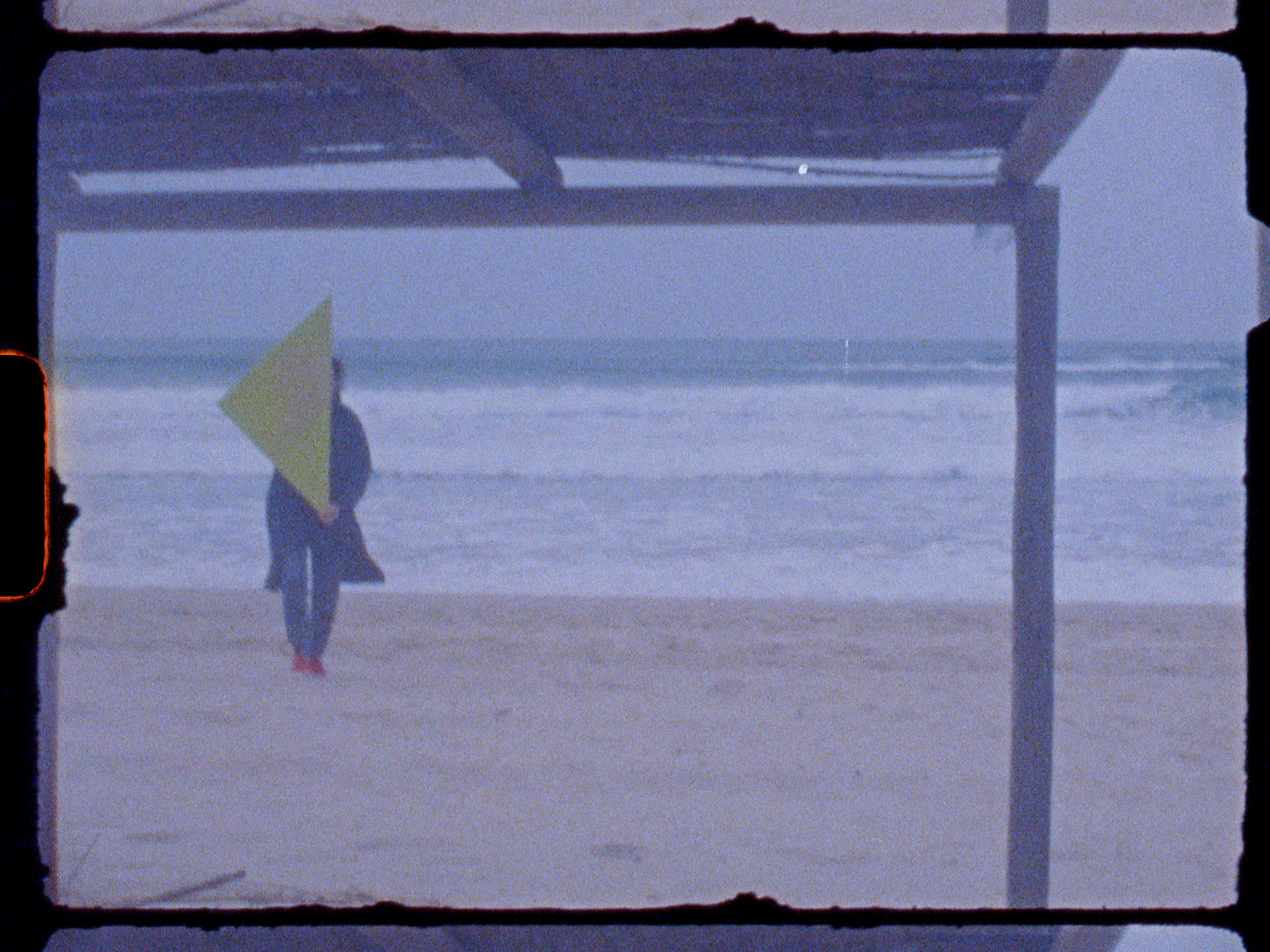
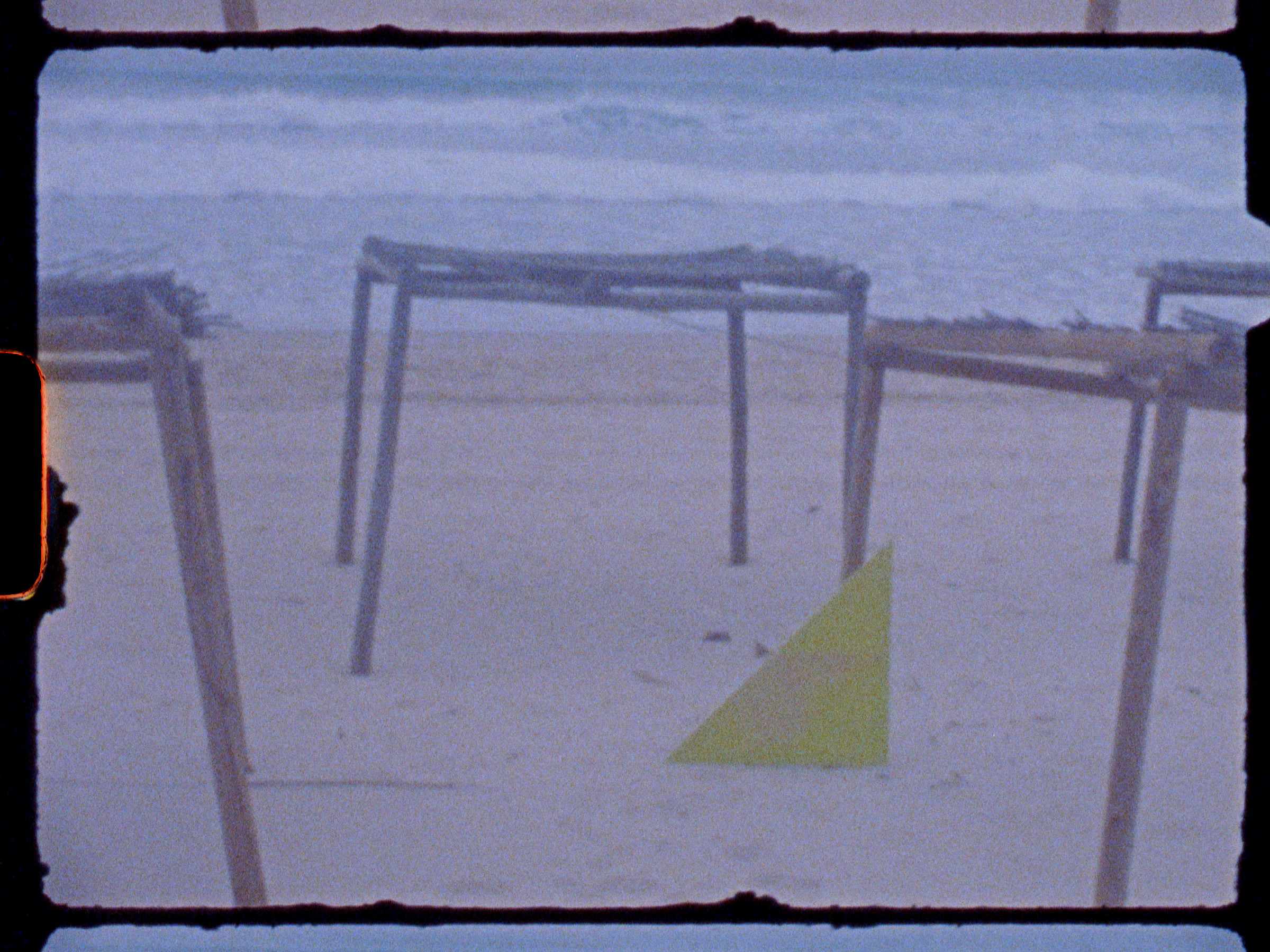
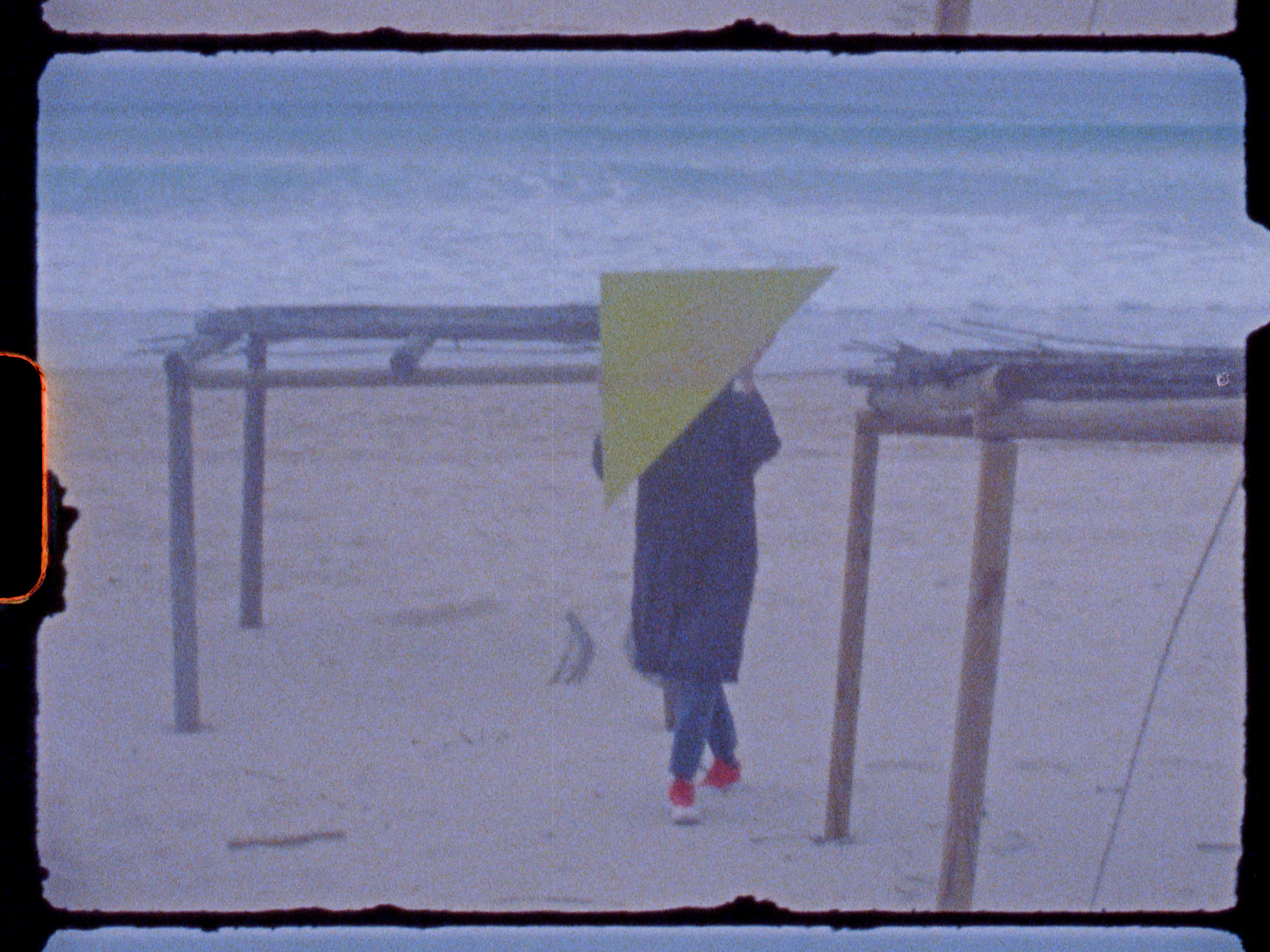
Film stills from Terra-Triangular, 2022–2023, by Ana Cardoso. Super 8 film transferred to digital video; 4 min 16 s. Music by Tim Pierson.
In The Order of Things: An Archaeology of the Human Sciences, Michel Foucault writes of Diego Velázquez’s Las Meninas (1656): “The tall, monotonous rectangle occupying the whole left portion of the real picture, and representing the back of the canvas within the picture, reconstitutes in the form of a surface the invisibility of depth of what the artist is observing: that space in which we are, and which we are.” (→ 1) The blockish recto of the painting announces itself, even as it announces us as viewers of the painting’s mise en abyme. In fact, this monotonous rectangle, necessarily devoid of colour, contains within it an A-frame triangle, as if the canvas were a tent whose structure is meant for shelter. A caring view of a painting’s humble support is what drives Ana Cardoso (Lisbon, 1978), especially in her film Terra-Triangular (2022–2023), wherein she personifies viewership as a friendly, wandering, pointy being.
- (1) Michel Foucault, The Order of Things: An Archeology of the Human Sciences (London and New York: Routledge, 2004), 4.
Yet, in Foucault’s description of Las Meninas, there is no shelter and there is no camaraderie. The aristocratic characters, who look upon us as we look at them, as we look at them and look at ourselves as reflections in the mirror, become paranoid, even violent triangulations of surveillance and exposure. This is not unexpected, given the aims of Foucault’s intellectual project. However, with Cardoso’s paintings and film, we get something more playful and optimistic, more akin to the cheeky, squiggly forms of Asger Jorn’s L’avant garde se rend pas [The avant-garde does not surrender] (1962) or the kinder pyramids of Ellsworth Kelly’s Three Panels: Orange, Dark Gray, Green (1986). I think that Cardoso, thankfully, is alright with some rambling comparisons, since she is herself one who productively rambles, just as her interlocking canvases ramble on in search of intimacy, community.
It follows that, in the tradition of theatre, which was so reviled by modernist art critics, Cardoso does not require her canvases to be wall-bound or to shun their audience. They move as we do, and they seek as we do. Her work gathers up painting’s modular forms, such as the mirror-rectangle, the doorway-rectangle, and the forgotten-and-humble-stretcher-triangle of Las Meninas, and reminds us that indispensable to these childlike-building blocks of perception is the shapeless, restless, desiring viewer. For even the most rigorously composed perspectival paintings cannot fully absorb us, since we are, despite having bodies, completely abstract. Cardoso characterises this intersection of form and formlessness, stillness and mobility, absorption and projection, as a “subconscious approach to make way for the body”, or a form of automatic writing. While the surrealists used automatic writing more or less as a masculinist and masturbatory process, Cardoso uses it generously, not hermetically. Her marks are calligraphic and intuitive and so close we could pick them like fruits embedded in the psyche, even as they lead us somewhere else, like the dotted footsteps on a treasure map or the chapters of a novel.
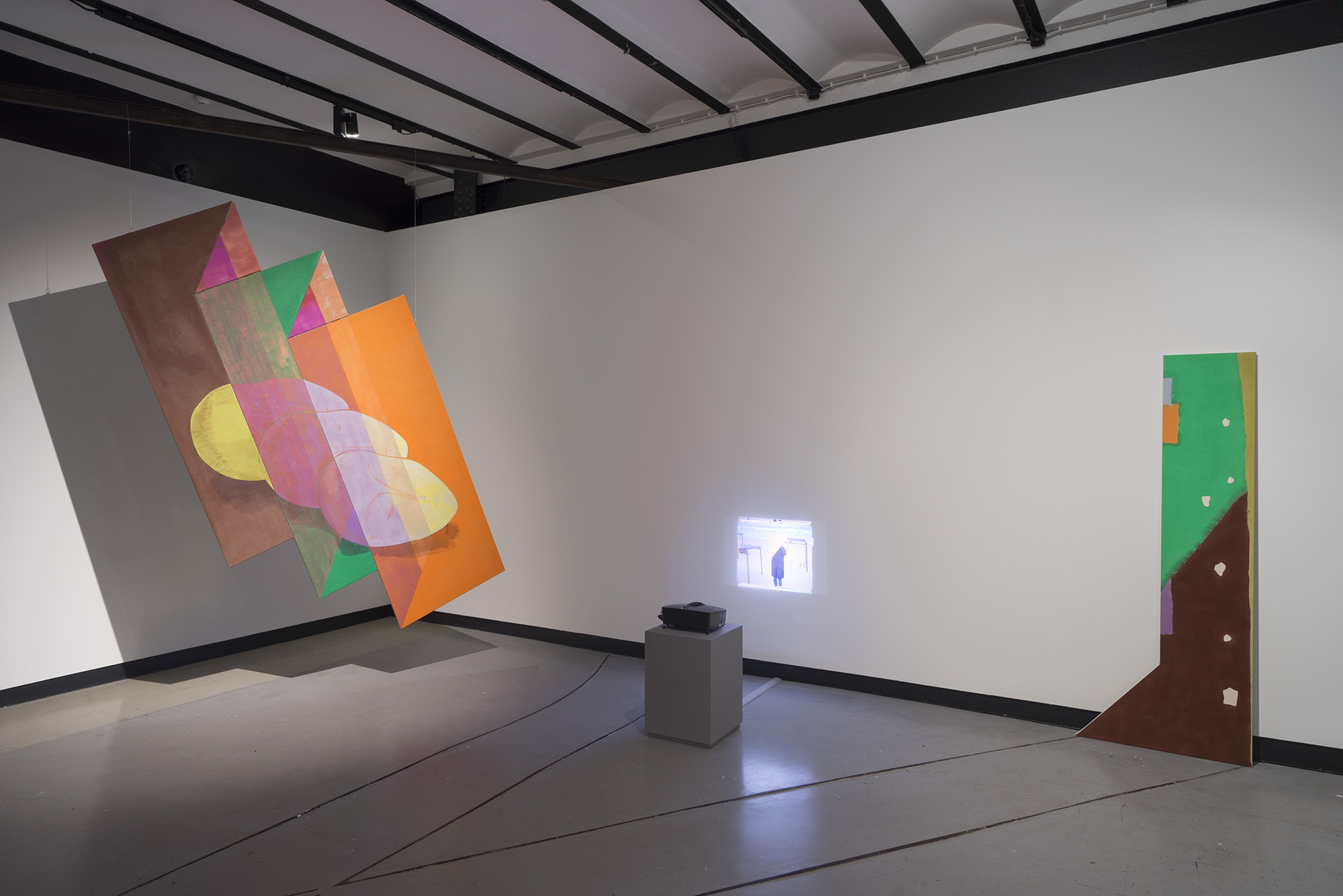
View of the exhibition Leaky Abstraction by Ana Cardoso (maat, 29/03–17/09/2023)) with the works Guardanapo-Dobrado (1+1+1=1), (2023, acrylic on sewn linen and cotton, 235 × 235 cm), Terra-Triangular (2022–2023, Super 8 film transferred to digital video, 4 min 16 s, music by Tim Pierson), and Cardume Obscuro (2023, acrylic on cotton, 183 × 78 cm). Photo: Nikolai Nekh, courtesy of EDP Foundation / maat.
We might turn to the kneeling, earthy pigments of Cardume Obscuro (2023), translated as “hazy shoal”, which submerge and emerge between land and sea. The beloved triangle becomes a leg, which transforms into an abstracted horizon line or shore. But it is not only a romantic painting whose aim is to relay the sublime to us in legible terms. Instead, it invests in abstraction, not only of colour and form, but also of the canvas itself, which breaks out of its boundary, its stage. Cardume Obscuro, with its starry dots, hearkens to transitional canvases between abstraction and figuration, painting and sculpture, such as Henri Matisse’s Luxe, calme et volupté (1904), whose subject is as much the figure as it is perception itself. Matisse’s shoal, like Cardoso’s, is both earth and a brushstroke.
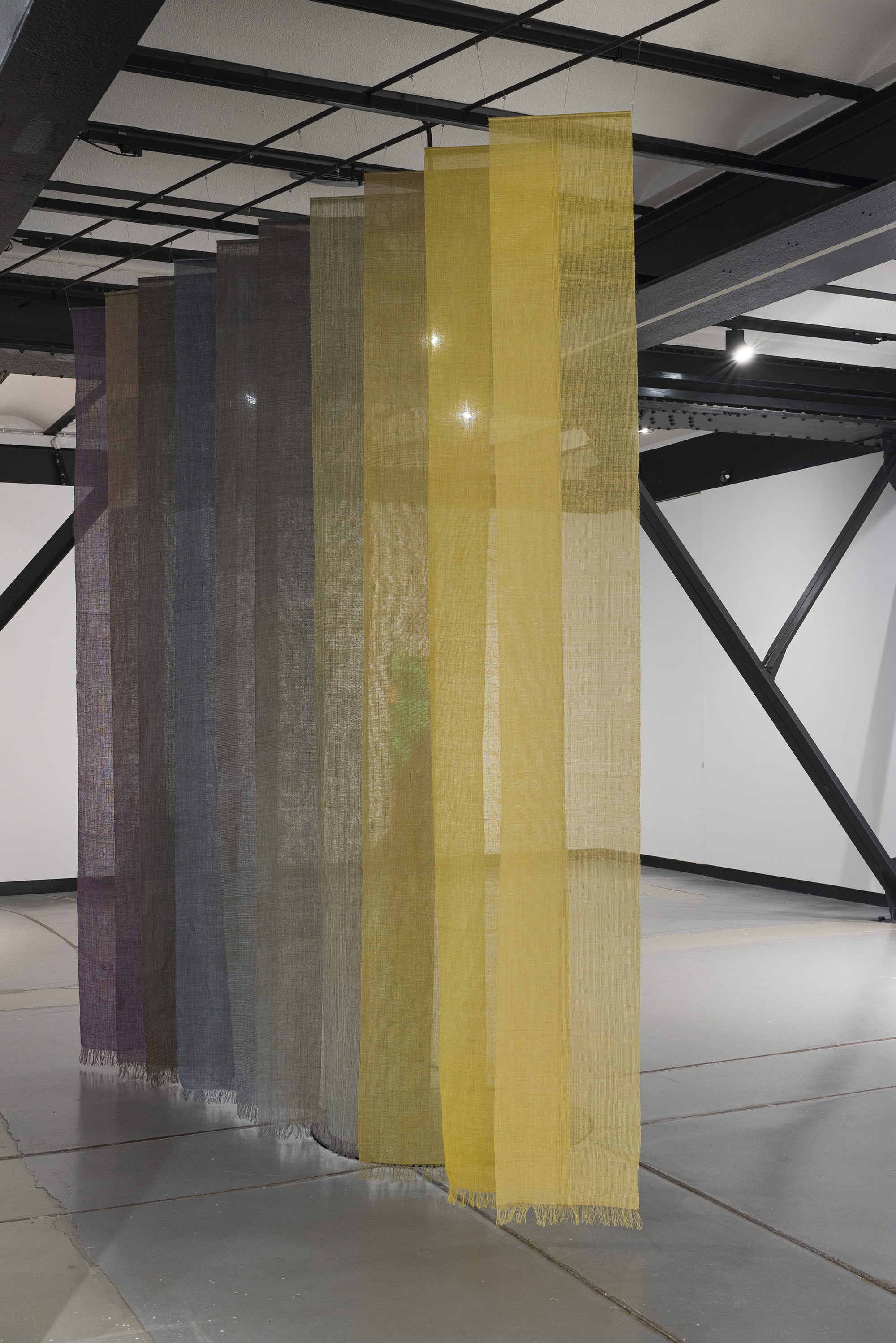
View of the exhibition Leaky Abstraction by Ana Cardoso (maat, 29/03–17/09/2023) with the work Tinturas (Natural Pigments) (2022, linen dyed with natural pigments and hand woven, 10 elements, 300 × 40 cm each). Photo: Nikolai Nekh, courtesy of EDP Foundation / maat.
We might also consider the hand-dyed and woven interventions of Cardoso’s Tinturas (Natural Pigments) (2022), which, unlike Daniel Buren’s infamous installation for the Sixth Guggenheim International Exhibition in 1971, is translucent and not masculinely rigid. Cardoso’s painting-sculpture-weaving therefore widens the neo-avantgarde to include a formalism that is neither about droll materialism (minimalism) or melodramatic self-disclosure (abstract expressionism). Her work is more akin to the craft-based, political aspirations of the Bauhaus. Anni Albers could be discussing Cardoso when she wrote, “Unburdened by any considerations of practical application, this uninhibited play with materials resulted in amazing objects, striking in their newness of conception in regard to use of color and compositional elements”. (→ 2)
- (2) Anni Albers, Annie Albers: Selected Writings on Design (Middletown, CT: Wesleyan University Press, 2000), 3.
With play, Cardoso makes way for painting’s trapped forms and activates them, like a procession that adds some whimsy to Velázquez’s dour menagerie. Whether her paintings are affixed to the gallery wall or on the move, she allows them to walk, and she allows herself to walk with them, and we walk hand-in-hand with them too. What results are the unplanned journeys of Cardoso’s painterly dérive, which is not a solidary trek. She is accompanied by pigment and its woven linen support, and with sound and the landscape and with family. All of this is not theatricality for theatricality’s sake, which sets Cardoso, Matisse-like, apart in the crowded field of contemporary painting. Her paintings, the products of a decade of labour and study, are multi-directional and gestural and rigorous. They set in motion an exchange of gifts, which is quite different from self-referentiality or performativity. Cardoso’s paintings are each of us, and we are not trapped by her or our or the paintings’ gazes. Instead, we are liberated. We are encouraged to step out, away, into.

View of the exhibition Leaky Abstraction by Ana Cardoso (maat, 29/03–17/09/2023) with the works Tinturas (Natural Pigments) (2022, linen dyed with natural pigments and hand woven, 10 elements, 300 × 40 cm each), Guardanapo-Dobrado (1+1+1=1), (2023, acrylic on sewn linen and cotton, 235 × 235 cm), Terra-Triangular (2022–2023, Super 8 film transferred to digital video, 4 min 16 s, music by Tim Pierson), and Cardume Obscuro (2023, acrylic on cotton, 183 × 78 cm). Photo: Nikolai Nekh, courtesy of EDP Foundation / maat.
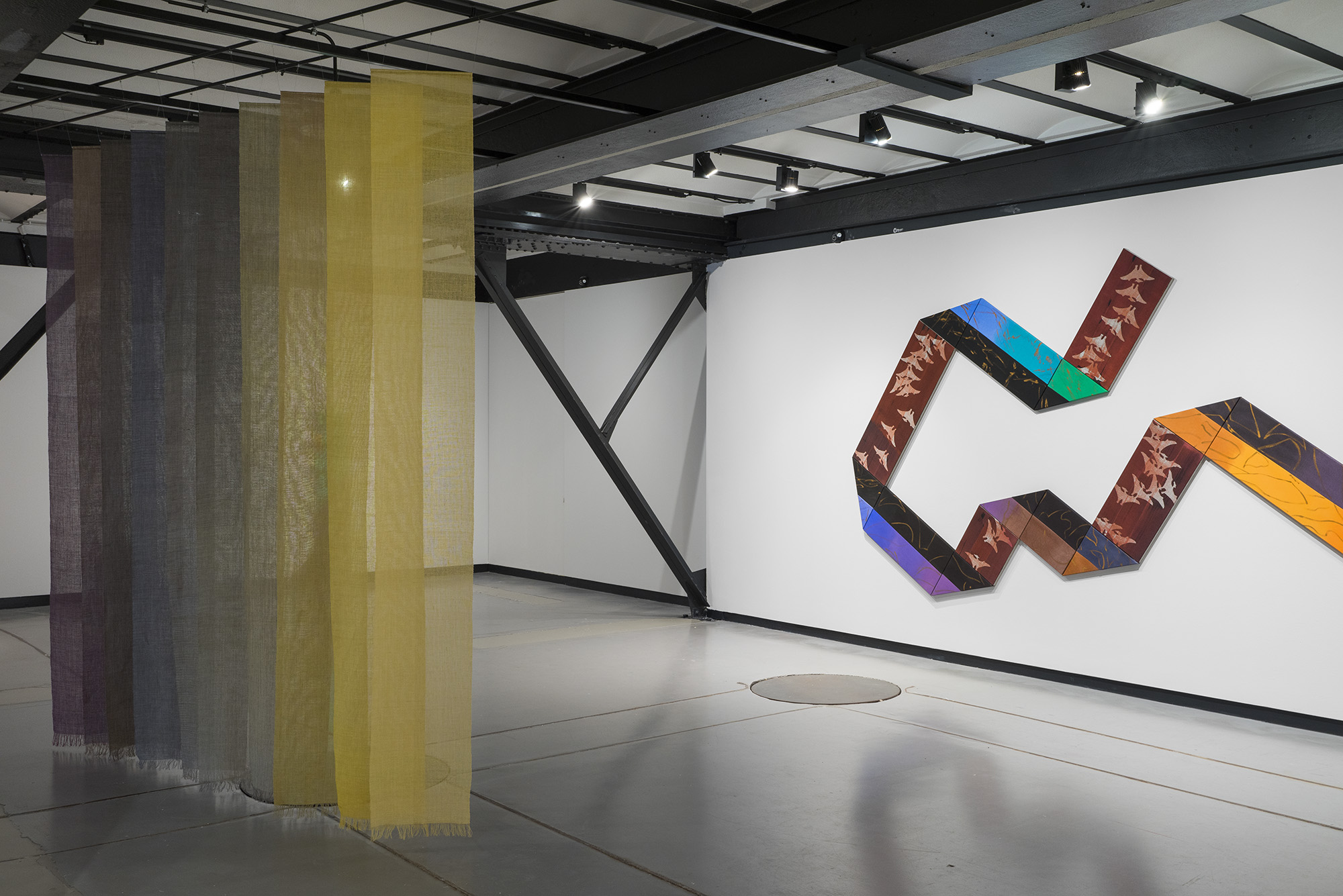
View of the exhibition Leaky Abstraction by Ana Cardoso (maat, 29/03–17/09/2023) with the works Tinturas (Natural Pigments) (2022, linen dyed with natural pigments and hand woven, 10 elements, 300 × 40 cm each), and Moléculas (Pterodactylus, Matisse, Etc.) (2022–2023, acrylic on sewn linen and cotton, 235 × 570 cm). Photo: Nikolai Nekh, courtesy of EDP Foundation / maat.
Views of the exhibition Leaky Abstraction by Ana Cardoso (maat, 29/03–17/09/2023). Photos: Nikolai Nekh, courtesy of EDP Foundation / maat.
William J. Simmons is a writer based in the Santa Clarita Valley north of Los Angeles. He is the author of Queer Formalism: The Return (Floating Opera Press, 2022).
Leaky Abstraction (maat, 29/03–17/09/2023), an exhibition by Ana Cardoso, is based on this artist’s research around the medium of painting. Exploring optical illusions allowed by the geometry of forms and a gestural and material based painting, Cardoso combines and simultaneously sabotages historical solutions of hard-edge and abstract painting with craft based practices: mixing or connecting dyed and hand-woven unpainted canvases with hand-painted industrial canvases, for instance. In her work, abstraction is grounded by a structure regulated by modular and geometric forms that are both independent and generic (although defined by the artist), – references to the history of abstraction, formalist strategies, etc. – as propositions for and of the body.






